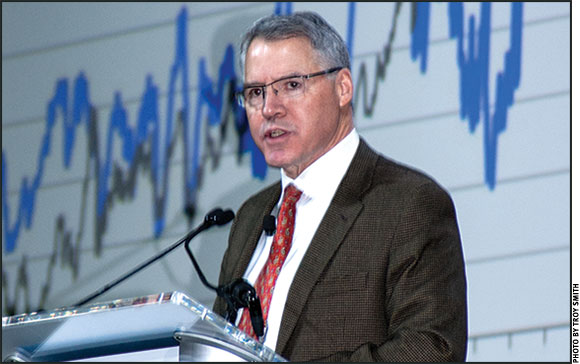MARKETING...

Blach Encourages Producers
To Look Ahead To ‘New Normal’
Markets beginning to stabilize.
“I know a lot of you have questions about these markets,” said CattleFax CEO Randy Blach as he opened the 2017 CattleFax Outlook Seminar Feb. 2. “It’s been one of the most volatile markets in history.”
To illustrate the market extremes, Blach cited the low prices of 2009, when fed cattle were selling at $80 per hundredweight (cwt.).
“A year later — boom — we woke up and fed cattle were at $173 per hundredweight,” he said. In jest, he added, “I’m sure you all forecasted that, too.” Read more.
Cattle Market Predictions
CattleFax analyst outlines his thoughts on the 2017 market.
Beef production was up 1.5 million pounds (lb.) year-over-year last year, Kevin Good told his audience at the National Cattlemen’s Beef Association (NCBA) Cattle Industry Convention in Nashville, Tenn., on Feb. 2. With poultry and pork production added in, that number increased to 3 million lb. Good, a senior analyst with CattleFax, addressed the audience at Thursday’s opening session.
Beef cattle production was up 14%, but at a level that suggests the herd is still expanding, Good explained. Total cattle inventories in the United States have increased nearly 5 million head in three years, totaling 93.4 million head in 2017. Read more.
Grain & Energy Outlook
CattleFax’s Mike Murphy predicts flat grain prices, but higher energy costs.
Thanks to record yields in 2016, record U.S. feedgrain supplies are in place. While larger livestock inventories are supportive of demand, and fewer U.S. acres are expected to be planted to corn, CattleFax Market Analyst Mike Murphy sees the corn supply and demand situation as fairly balanced. Murphy talked about production and prices of grain, hay and energy during the CattleFax Outlook Seminar Feb. 2 at the 2017 Cattle Industry Convention in Nashville, Tenn. Read more.
In The Cattle Markets
What about trade?
Friday, Feb. 10, Japanese Prime Minister Shinzo Abe met with U.S. President Donald Trump on several issues, including potentially laying the groundwork for a bilateral trade agreement. With the withdrawal from the Trans-Pacific Partnership (TPP), a bilateral agreement with Japan is important to the U.S. cattle industry.
U.S. beef exports are expected to grow 5.6% in 2017, and the United States is expected to retain the position of fourth-largest exporter in the world, behind Brazil, India and Australia. In 2016, almost 26% of total U.S. exports went to Japan, 18% to South Korea, 15% to Mexico and 12% to Canada. Uncertainty regarding trade policy exposes the beef and cattle industry to less-favorable trade policies and, potentially, a loss of market share in some of these most profitable markets. Read more.

Ginette Gottswiller
The Source
Learn to get more than what you pay for.
“You get what you pay for.”
How many times have you heard that statement?
Many times people equate higher cost with a better product. It is easy to compare ingredients or weight of a product to determine which one is the best choice. It can be hard to compare two feeder-calf programs to determine which one will work the best for each individual producer.
In the past few years, several value-added feeder-calf marketing programs have sprung up. Some cost around $8 per head to enroll and you may need to purchase an ear tag to denote they are enrolled. Read more.
Beef Exports Gaining Momentum
With nearly $300 per head in carcass value on the line, trade specialists share insights on current trade issues.
The United States is in a uniquely favorable position to build on recently strong beef export sales, according to Dan Halstrom with the U.S. Meat Export Federation (USMEF) and Kent Bacus of the National Cattlemen’s Beef Association (NCBA). The trade specialists summarized U.S. beef’s current status in world markets for the “Industry Hot Topics” session at Cattlemen’s College Feb. 1, as part of the 2017 Cattle Industry Convention & NCBA Trade Show in Nashville, Tenn.
Momentum had November 2016 beef exports accounting for $294 worth of carcass value, a monthly high that could give way to December when the tallying is done, said Halstrom, USMEF senior vice president for global marketing. The annual record eclipsed $300 per head in 2014.
With multilateral trade deals canceled, on hold or subject to renegotiation this winter, Halstrom said U.S. beef owes much of its current strength in Asian markets to higher quality than the Australian alternative. Moreover, that competitor’s mostly grass-fed product has been rising in price because drought recovery after four years has triggered expansion Down Under. Read more.
International Trade Plans May Lead to Recession
Agriculture would be negatively affected with current global trade plans.
If the Trump administration follows through on international trade plans, the United States would see increased unemployment and a recession, according to an agricultural economist at the Ohio State University.
Ian Sheldon, the Andersons Chair in Agricultural Marketing, Trade and Policy in the Department of Agricultural, Environmental, and Development Economics (AEDE), said if Trump were to implement a 45% tariff against China and a 35% tariff against Mexico, “He’s going to put the economy into a recession, if the Chinese and Mexicans retaliate, as I expect them to do.” Read more.
Angus Calendar
To view the Angus Calendar, a comprehensive list of Angus sales, click here.






